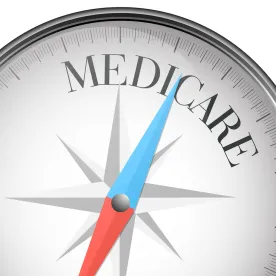One emerging key issue is whether “authoritative guidance might have warned defendant away from” their interpretation. Squaring Allergan’s “authoritative guidance” requirement with other Supreme Court precedent on the enforceability of Medicare sub-regulatory guidance will be the subject of more litigation in the future.
Azar v. Allina Health Services
The US Department of Health and Human Services (HHS) began an examination of its guidance practices, and use of guidance, following the Supreme Court’s’ June 2019 decision in Azar v. Allina Health Services, et al. [1] The Court held that agency guidance that represents a change in a “substantive legal standard” within the meaning of Section 1871(a)(2) of the Social Security Act (SSA) must be issued through notice-and-comment procedures. The Court explained that the “substantive legal standard” under Section 1871(a)(2) means any legal standard or determination that creates rights and obligations, such as the scope of benefits; payment for services; eligibility of individuals to receive benefits; or eligibility of individuals, entities or organizations to furnish services.
Since the Court’s decision, lower courts have attempted to distinguish what Medicare guidance is enforceable and what is not. Four recent cases have weighed in on this question:
-
The US District Court for the Central District of California held in Agendia, Inc. v. Azar that a local coverage determination (LCD) and related policy articles by a Medicare Administrative Contractor (MAC) were not enforceable. According to the court, those guidance documents constituted “substantive legal standards” that were “unlawfully promulgated without notice and comment.” [2] The Ninth Circuit reversed, holding 2–1 that the Medicare Act’s notice-and-comment requirements at 42 USC § 1395hh do not apply to LCDs because they do not “establish[] or change[] a substantive legal standard.” [3] The court held that LCDs only bind the MACs’ coverage determinations, whereas qualified independent contractors, administrative law judges (ALJ)s and the Medicare Appeals Council remain obligated to apply the reasonable and necessary statutory standard in adjudicating appeals. [4]
-
The US District Court for the Middle District of Tennessee declined to hold that all LCDs are unenforceable. In United States v. Anesthesia Servs. Assocs., PLLC, defendants were accused of not complying with an LCD and sought dismissal of the False Claims Act (FCA) claim by arguing that the LCD was “not promulgated in accordance with notice and comment procedures.” [5] Noting that the parties did not fully brief the issue, the court nonetheless held that “an LCD may give rise to an FCA claim” and refused to dismiss. [6] Given the lack of briefing, the court may not have known that LCDs are not binding on HHS, and that the HHS Office of the General Counsel (OGC) Memo, discussed below, instructed CMS that LCDs do not establish or change substantive legal standards and therefore cannot support enforcement actions.
-
In Polansky v. Exec. Health Res., Inc., the US District Court for the Eastern District of Pennsylvania granted summary judgment in favor of the defendants. [7] The relator alleged that, for periods before October 1, 2013, defendants failed to comply with guidance published in the Medicare Hospital Manual that instructed physicians to admit individuals as inpatients only if the physician believes a patient would be in the hospital for longer than 24 hours, known as the “two-midnight” rule. [8] The court determined that the Medicare Hospital Manual guidance, which did not go through formal notice-and-comment rulemaking, was a “substantive legal standard” under the SSA because the guidance “affects a hospital’s right to payment.” [9] The court granted defendants’ summary judgment motion, and the Third Circuit affirmed. [10] A petition for a writ of certiorari has been docketed at the Supreme Court, and a response is due on May 3, 2022.
-
In Dobson v. Azar, the US District Court for the Southern District of Florida ruled that the Medicare Appeals Council may uphold an ALJ decision to deny a Medicare beneficiary drug coverage based in part on subregulatory guidance from the Prescription Drug Benefit Manual (PDBM). [11] The court held that the PDBM “does not carry the force of law but still clarified what ‘medically accepted indication’ entails.” [12] The court also found that “[a]lthough the PDBM does not bind ALJs and the Council, they must be accorded substantial deference if they are applicable to a particular case.” [13] In an unpublished per curiam opinion, the Eleventh Circuit vacated the district court’s ruling and held that the statutory term “medically accepted indication” includes off-label drug uses that are supported by a medical compendium establishing the “efficacy and safety of the prescribed off-label use.” [14]
OGC Memo
In November 2019, the CMS OGC released a memo (that was made public) to instruct the department on how to interpret and implement Azar v. Allina Health Services, et al. The memo describes CMS guidance documents that set forth interpretive payment rules, such as the Medicare Internet-Only Manuals, as legally nonbinding and states that they may not be used as the basis of an enforcement action. However, according to the memo, CMS guidance documents that are “closely tied to a statutory or regulatory requirement” may provide additional clarity, and enforcement actions implicating the guidance can still be brought. Further, even if the subregulatory guidance is not specifically enforceable as a substantive legal standard, it can be used for other purposes, such as scienter or materiality, as stated in the US Department of Justice (DOJ) Brand Memo.
Good Guidance and Civil Enforcement Rules Creation and Proposed Repeal
In December 2020, at the end of the Trump Administration, HHS issued two final rules that attempted to further regulate and curtail HHS guidance practices: the Good Guidance Practices Rule (Good Guidance Rule) and the HHS Transparency and Fairness in Civil Administrative Enforcement Actions Rule (Civil Enforcement Rule).
The Good Guidance Rule included four major changes to HHS’s previous approach to guidance documents. First, the rule imposed a requirement that each guidance document issued by HHS include a statement that the guidance document does not have the effect of law and does not impose a binding obligation unless included in a contract. Second, the Good Guidance Rule created new procedures for what HHS classified as “significant guidance documents.” These procedures include notice-and-comment rulemaking, a requirement that the HHS Secretary approve the guidance, and submission to the Office of Information and Regulatory Affairs for review under Executive Order 12866. [15] Third, the Good Guidance Rule required that HHS create a repository for all guidance documents, and required that any guidance document not located in the repository be considered rescinded. Finally, the Good Guidance Rule established a process by which the public could petition HHS to withdraw or revise a particular guidance document.
HHS issued the Civil Enforcement Rule without notice and comment as a procedural rule, whereas the Good Guidance Rule was promulgated following notice-and-comment rulemaking. The Civil Enforcement Rule included several provisions, including the following requirements:
-
HHS may only apply standards and practices in civil enforcement actions that have been publicly announced.
-
HHS must publish in the Federal Register or the HHS guidance document repository any assertions of new or expanded jurisdiction before asserting such jurisdiction over regulated parties’ conduct in a civil enforcement action.
-
HHS must provide regulated parties with written notice of its initial legal and factual determinations, an opportunity to respond to the same, and, if requested, a written response to the parties’ response, all before initiating a civil enforcement action.
On October 20, 2021, HHS issued a proposed rule to repeal both of these rules, citing concerns that they created “unnecessary hurdles” that would make it more difficult for HHS to issue guidance, bring enforcement action or take actions to advance its mission. [16]
DOJ’s Garland Memo
On July 1, 2021, US Attorney General Merrick Garland issued a memorandum on the “Issuance and Use of Guidance Documents by the Department of Justice” (Garland Memo). The Garland Memo reemphasized that guidance documents issued by an agency “do not have the force and effect of law.” [17] The Garland Memo rescinded two memoranda issued by the Trump Administration, which limited the DOJ’s ability to issue and utilize guidance documents. The Garland Memo stated that the DOJ should clearly label guidance documents as such and should cite to the binding legal authority that serves as the legal basis for a guidance document. The Garland Memo also explained that enforcement actions cannot be based on guidance documents alone because such documents do not create binding obligations.
Takeaways
Amid these developments, agencies continue to use sub-regulatory guidance documents to state their legal interpretations of the statutes governing their programs. While guidance documents are not legally binding and do not impose obligations on regulated parties, these documents can help inform the regulated community about how the agency views a particular issue, which can improve clarity and efficiency for parties aiming to comply with often complex regulatory requirements.
That said, if a statute has multiple interpretations, it is not obvious that the agency’s guidance interpreting the statute is the only interpretation permitted, or whether an organization could also have a different yet still objectively reasonable interpretation. What qualifies as authoritative guidance, and how to marry the “substantive legal standard” and “authoritative guidance” tests is likely be a focus of debate and litigation in future FCA cases. The pending repeal of the Good Guidance Rule and the Civil Enforcement Rule does not change judicial decisions that have interpreted when HHS is required to use notice-and-comment rulemaking under the SSA. Defendants in healthcare enforcement actions should continue to challenge such actions where the liability theory is based on subregulatory guidance documents.
In addition, organizations or trade associations should consider submitting comments to HHS that explains an interpretation of a particular ambiguous issue and ask for clarity. The Allergan court found it relevant that Forest submitted comments to CMS during rulemaking on the rebate issue and CMS declined to provide more clarity in finding that there was no authoritative guidance contradicting Forest’s interpretation. There are plenty of other places in CMS guidance where intentional ambiguity exists, which opens the door for organizations to construct an objectively reasonable alternative interpretation. One way to document that interpretation is to submit comments to CMS during rulemaking or, even if the Good Guidance Rule is repealed, on existing guidance. Of course, this could result in CMS taking a position that is different from one advocated by the organization. As a result, this strategy should be thoughtfully considered depending on the organization’s particular circumstances.
-
Several other hospital and health systems were also parties in filing this lawsuit.
-
420 F. Supp. 3d 985, 998 (C.D. Cal. 2019).
-
Agendia, Inc. v. Becerra, 4 F.4th 896, 900 (9th Cir. 2021)(quoting 42 U.S.C § 1395hh).
-
Id.
-
No. #:16-cv-0549, 2019 WL 7372510, at *15 (M.D. Tenn. Dec. 31, 2019).
-
Id. at *16
-
422 F.Supp.3d 916 (E.D. Pa. Nov. 5, 2019).
-
78 Fed. Reg. 50496 (Aug. 19, 2013) (codified as amended at 42 C.F.R. § 412.3(d)(1)).
-
Id. at 935 (quoting Allina, 139 S. Ct. at 1811).
-
Polansky v. Executive Health Resources, Inc.,17 F.4th 373 (3d Cir. 2021).
-
451 F.Supp.3d 1346 (S.D. Fla. Mar. 31, 2020).
-
Id. at 1357.
-
Id.
-
Dobson v. Sec’y of Health & Human Servs., 2022 WL 424813 (3d Cir. Feb. 11, 2022).
-
This executive order requires significant regulatory actions to be submitted to the Office of Management and Budget (“OMB”) for review.
-
86 Fed. Reg. 58043 (Oct. 20, 2021).
-
Garland Memo, citing Perez v. Mortgage Bankers Ass’n, 575 U.S. 92, 97 (2015) (quoting Shalala v. Guernsey Mem’l Hosp., 514 U.S. 87, 99 (1995)).






 />i
/>i

